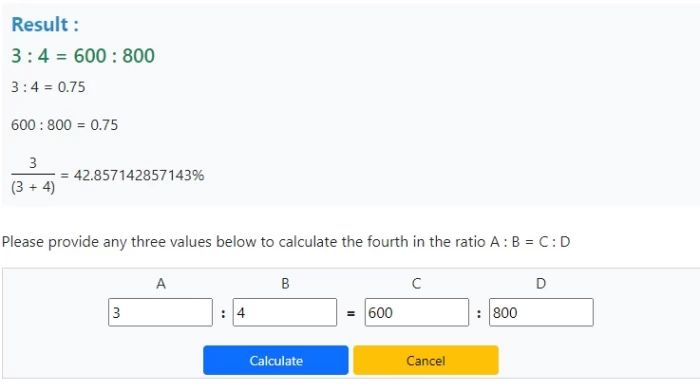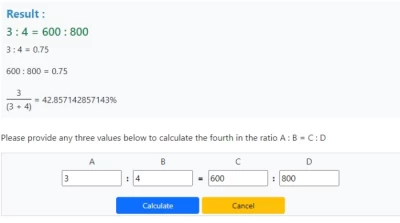Unveiling the Essence of Ratios: Explore with Our Ratio Calculator
Our Ratio Calculator goes beyond traditional comparisons, automating calculations for quick and precise results.

Concept of Ratio:
At its core, a ratio is a way of expressing the relationship between two or more quantities. It's like a mathematical shorthand that helps us compare and analyze different elements. A ratio is typically written as a:b, where 'a' and 'b' are the quantities being compared. Ratio calculators take this concept a step further by automating the calculation process and providing quick and accurate results.
Historical Background:
The concept of ratio is a rich historical tapestry, originating in Ancient Egypt around 3000 BCE, where ratios were crucial in constructing structures like the pyramids. The Ancient Greeks, mainly through Euclid's "Elements," furthered the understanding of ratios, applying them in geometry, music theory, and astronomy. In the Islamic Golden Age, scholars like Al-Khwarizmi and Omar Khayyam expanded upon Greek mathematical knowledge, ensuring its cross-cultural transmission.
During the Renaissance, figures like Leonardo da Vinci and Luca Pacioli utilized ratios in art, architecture, and accounting, emphasizing their practical significance. The Industrial Revolution marked a turning point, with ratios becoming indispensable in engineering and manufacturing for precise measurements and standardized production. Throughout history, ratios have demonstrated their adaptability, shaping diverse fields and contributing to the efficiency of various industries, reflecting their enduring importance across millennia.
Ratio Calculator:
A ratio calculator is a tool that helps you compare the sizes of two or more quantities. It takes the values of different things and shows how many times one value is contained within another. For example, if you have two boxes and one has five red balls while the other has three blue balls, the ratio of red balls to blue balls is 5:3. A ratio calculator can help you find or simplify such ratios, making it easier to understand and compare different quantities.

Real-Life Applications:
- Finance and Business: In finance, ratios are crucial for assessing a company's financial health. Ratio calculators help investors and analysts evaluate profitability, liquidity, and solvency ratios, aiding in investment decisions.
- Cooking and Recipes: Have you ever tried scaling down a recipe or adjusting ingredient quantities? Ratio calculators simplify the process, ensuring the right proportions for a delicious outcome.
- Health and Fitness: Ratios play a role in nutrition and fitness. Whether you're planning a balanced diet or adjusting workout intensity, ratio calculators assist in maintaining the right balance for a healthy lifestyle.
- Engineering and Construction: Architects and engineers use ratios to determine proportions in designs and construction. Ratio calculators help streamline these calculations, ensuring structural integrity and aesthetic appeal.
- Education: Teachers and students benefit from ratio calculators in math classes. These tools make learning about ratios more engaging and practical, fostering a deeper understanding of mathematical concepts.
- Art and Design: Artists use ratios to create visually appealing compositions. Whether it's the dimensions of a painting or the proportions of a sculpture, ratio calculators contribute to the artistic process. If you're interested in exploring additional calculators, check out CoolCalculator for a variety of useful tools.

Concept of Ratio:
At its core, a ratio is a way of expressing the relationship between two or more quantities. It's like a mathematical shorthand that helps us compare and analyze different elements. A ratio is typically written as a:b, where 'a' and 'b' are the quantities being compared. Ratio calculators take this concept a step further by automating the calculation process and providing quick and accurate results.
Historical Background:
The concept of ratio is a rich historical tapestry, originating in Ancient Egypt around 3000 BCE, where ratios were crucial in constructing structures like the pyramids. The Ancient Greeks, mainly through Euclid's "Elements," furthered the understanding of ratios, applying them in geometry, music theory, and astronomy. In the Islamic Golden Age, scholars like Al-Khwarizmi and Omar Khayyam expanded upon Greek mathematical knowledge, ensuring its cross-cultural transmission.
During the Renaissance, figures like Leonardo da Vinci and Luca Pacioli utilized ratios in art, architecture, and accounting, emphasizing their practical significance. The Industrial Revolution marked a turning point, with ratios becoming indispensable in engineering and manufacturing for precise measurements and standardized production. Throughout history, ratios have demonstrated their adaptability, shaping diverse fields and contributing to the efficiency of various industries, reflecting their enduring importance across millennia.
Ratio Calculator:
A ratio calculator is a tool that helps you compare the sizes of two or more quantities. It takes the values of different things and shows how many times one value is contained within another. For example, if you have two boxes and one has five red balls while the other has three blue balls, the ratio of red balls to blue balls is 5:3. A ratio calculator can help you find or simplify such ratios, making it easier to understand and compare different quantities.

Real-Life Applications:
- Finance and Business: In finance, ratios are crucial for assessing a company's financial health. Ratio calculators help investors and analysts evaluate profitability, liquidity, and solvency ratios, aiding in investment decisions.
- Cooking and Recipes: Have you ever tried scaling down a recipe or adjusting ingredient quantities? Ratio calculators simplify the process, ensuring the right proportions for a delicious outcome.
- Health and Fitness: Ratios play a role in nutrition and fitness. Whether you're planning a balanced diet or adjusting workout intensity, ratio calculators assist in maintaining the right balance for a healthy lifestyle.
- Engineering and Construction: Architects and engineers use ratios to determine proportions in designs and construction. Ratio calculators help streamline these calculations, ensuring structural integrity and aesthetic appeal.
- Education: Teachers and students benefit from ratio calculators in math classes. These tools make learning about ratios more engaging and practical, fostering a deeper understanding of mathematical concepts.
- Art and Design: Artists use ratios to create visually appealing compositions. Whether it's the dimensions of a painting or the proportions of a sculpture, ratio calculators contribute to the artistic process. If you're interested in exploring additional calculators, check out CoolCalculator for a variety of useful tools.
Conversation
Latest Blogs
© Blog CoolCalculator, Explore CoolCalculator, your destination for the latest insights, tips, and updates on the world of online calculators. Stay informed and make your calculations smarter with our blog. ,
Designed
by Saad Media Team , Team Lead M.Rizwan Akhtar












